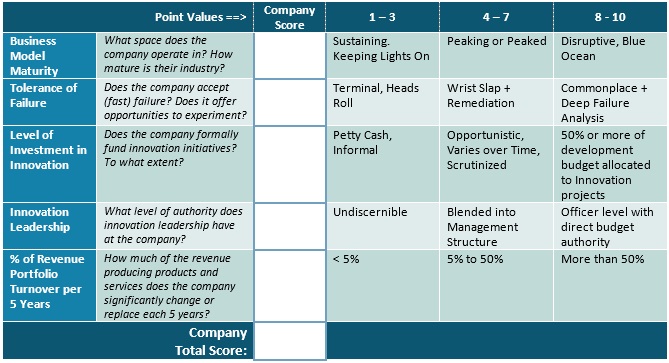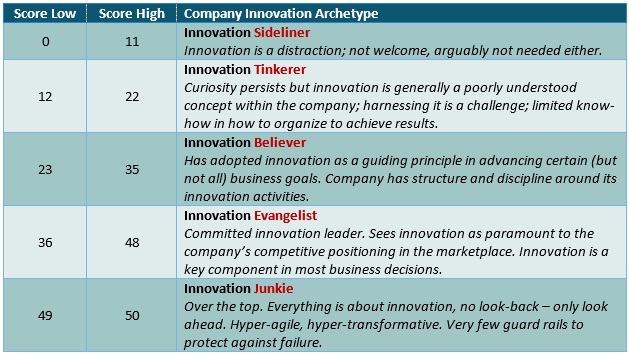Bridging the Innovation Alignment Gap
Creating Innovation Alignment between a Company and its Service Provider
 In the years of building and managing an innovation practice, the one thing that I’ve concluded is that innovation means different things to different companies. And while most companies insist that their vendors and service providers be innovative, seldom does this provide a clear direction as to what they expect and how the service providers can deliver on these expectations. Hence, alignment in expectations is frequently not achieved.
In the years of building and managing an innovation practice, the one thing that I’ve concluded is that innovation means different things to different companies. And while most companies insist that their vendors and service providers be innovative, seldom does this provide a clear direction as to what they expect and how the service providers can deliver on these expectations. Hence, alignment in expectations is frequently not achieved.
One way that provides a good analysis-based approach to improved innovation alignment between a company and its service provider is to clarify, and ultimately understand the company’s innovation frame of reference. By categorizing a company in terms of its innovation posture, the service provider can begin to identify appropriate alignment vectors and develop strategies which optimally sync up with their client’s innovation mindset. In the end, this creates a much improved understanding of their client’s expectations and a smoother path to working together to meet and exceed them.
Following is a tool that I find helpful in cataloging and quantifying a company’s innovation characteristics. To score a company, pick a number from the range in the corresponding column for each characteristic, then sum the results.
Table 1
Assessing a Company’s Innovation Profile
Using the Total Score we can identify an Innovation Archetype for the company as follows:
Table 2
Determining the Company’s Innovation Archetype
Once the service provider identifies its client’s profile, it can begin to strategically position activities using the language, methods and behaviors that are appropriate for its client’s archetype. The service provider might consider the following:
Innovation Sideliner. Attempts to engage in discussions around innovative solutions will likely fall on deaf ears with this company. It wants to keep things as they are; stability and operational consistency is a leading objective. It is typically counterproductive to go against the grain of a Sideliner’s operating model. This company is seeking to work with established products, purchased at a good price with five-nines availability. Full stop.
Innovation Tinkerer. This company is a good opportunity for the service provider to begin building a strategic relationship with the company’s budding center(s) of innovation, to better understand and identify future opportunities. Here the service provider and the company can start to ideate around how to address business opportunities that may still be 4 to 6 quarters out.
Innovation Believer. This company is half on the fence, in transition and the service provider needs to be smart to identify where innovation resonates and where it is not yet ready to be adopted. The power base in this company is likely to be on the side of the innovators; the service provider needs to identify them and align itself with their goals. The company will likely be receptive to the service provider organizing innovation activities that promote ideation around out-of-the-box solutions; immersive field engagements or innovation workshops are excellent examples. But both the service provider and the company’s innovators should be astute to recognize that status-quo supporters yield much influence and they should not be alienated from innovation programs.
Innovation Evangelist. The service provider needs to be highly innovative with this company or suffer the miserable consequences of being relegated to the procurement abyss. With an Evangelist the service provider always needs to lead with an innovation angle. Even when dealing with normalized products, the company wants to see the service provider offer creative solutions which stretch or enhance their value. Examples include complex integrations with tangential solutions that ideally are business (not IT) related. The company expects the service provider to be consistently innovative. Every engagement must crank it up a notch, or others are waiting in the wings to fill the service provider’s spot. Competition in serving Innovation Evangelists is fierce and these companies like it that way.
Innovation Junkie. This company’s entire business model is about transformation and it has organized itself to be ultra-agile and will only work with service providers that are equally so. Typically these companies are in a startup or aggressive growth mode and their needs change very rapidly. They are serviced by a category of service providers that are able to transform themselves in pace with the company. Form a service provider’s perspective, working with an innovation junkie is exhilarating, but seldom can established service providers maintain a profitable relationship with this company, so they are exchanged out frequently.
Which innovation archetype am I? A company knowing and understanding its innovation profile can better gauge and be able to articulate the level and type of service it expects from its service provider.
How well have I aligned my services and my engagement model to my client’s innovation expectations? A deeper understanding of its engagement model will help optimize the service provider’s sales, marketing and support activities with the client.
* * * * *
Bringing the company’s expectations and the service provider’s client engagement model into innovation alignment creates efficiencies and positively impacts on client satisfaction and other metrics of the service provider’s performance.

